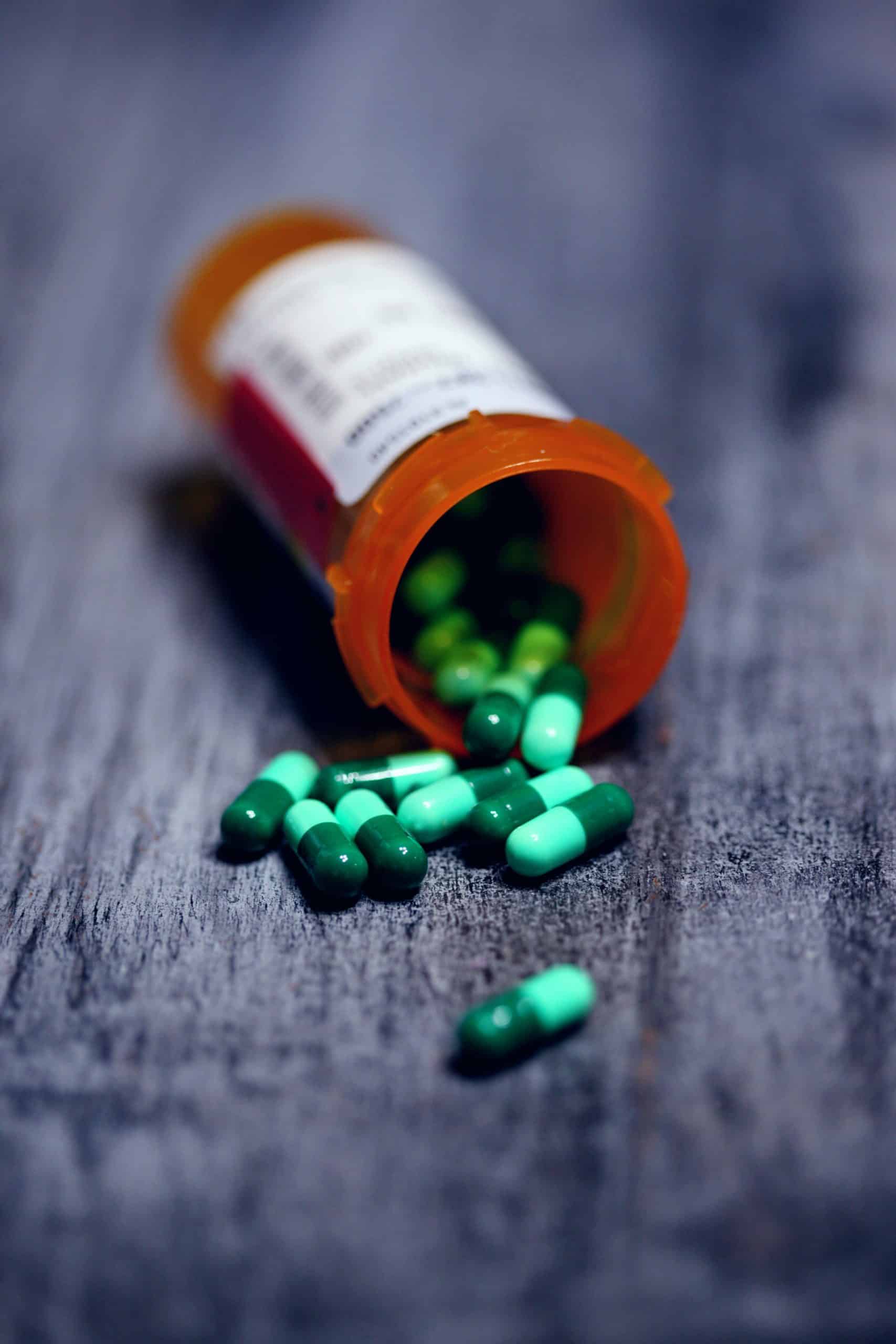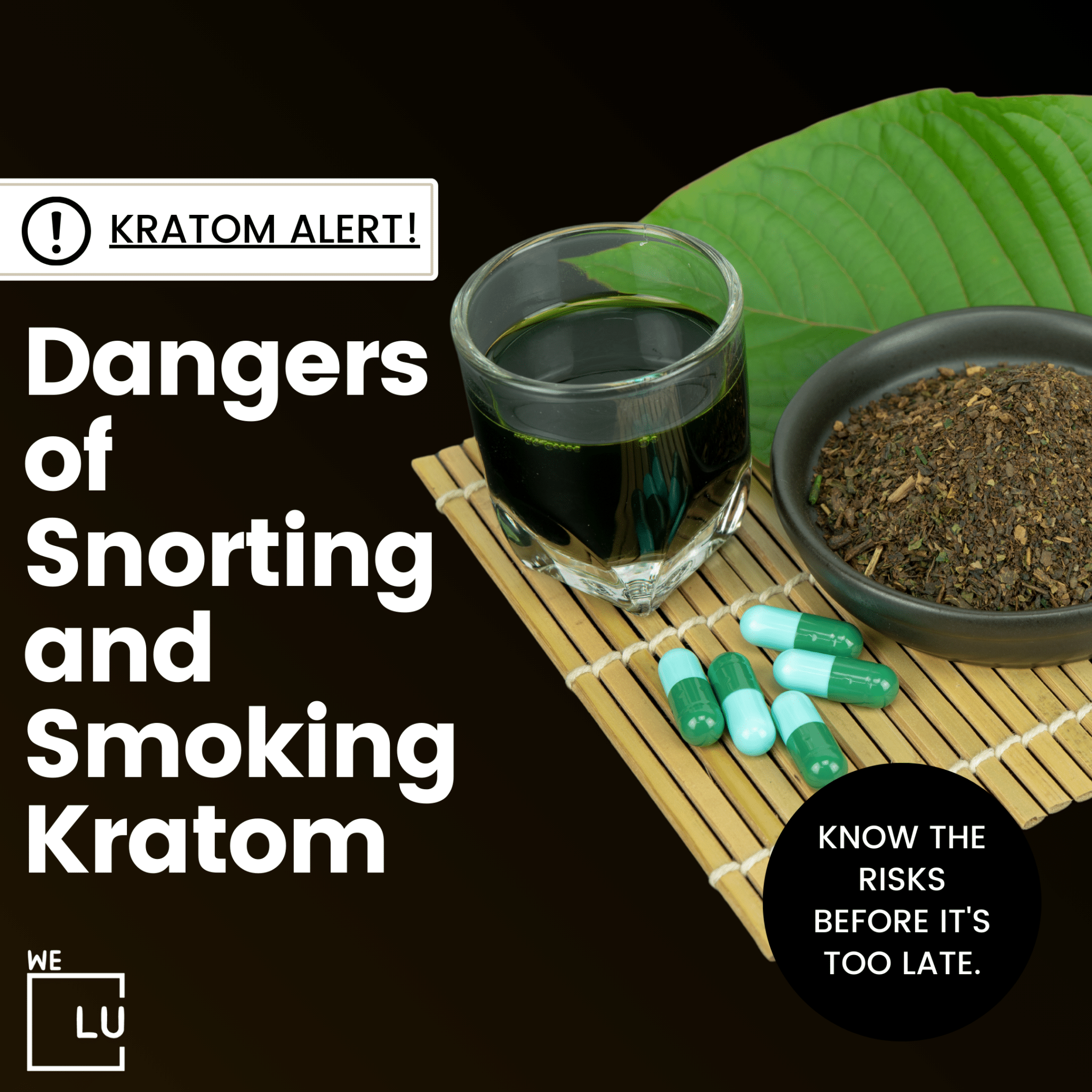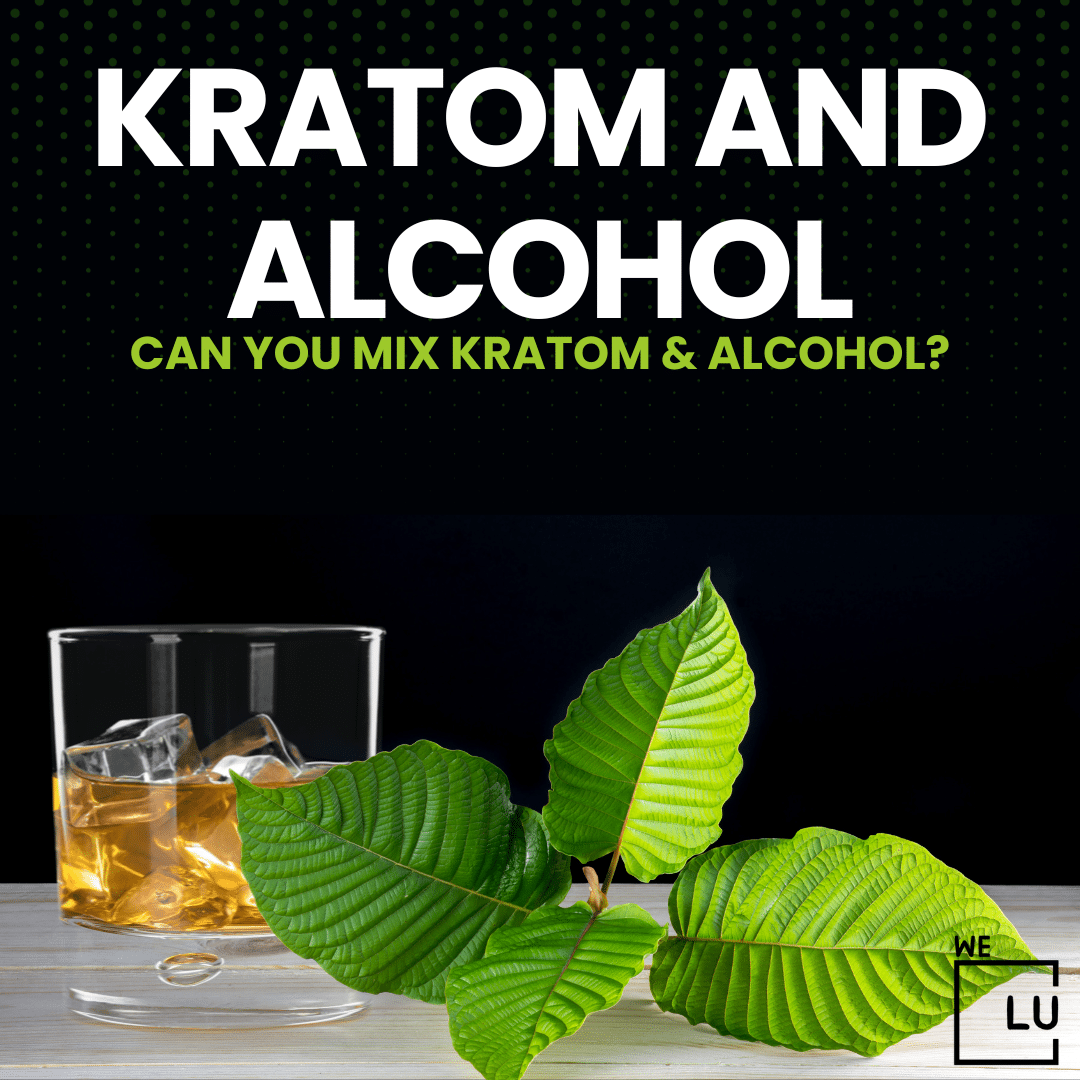What Is Fake Meth?
“Fake meth” typically refers to substances that resemble methamphetamine but do not contain the drug. Methamphetamine, commonly known as meth, is a powerful and highly addictive central nervous system stimulant. It is illegal in most places without a prescription.
Fake meth can take various forms, and it might include substances that mimic the appearance of genuine methamphetamine crystals or powder. These substances could be entirely different drugs or non-drug substances designed to deceive users. The reasons for creating fake meth can vary and may include attempts to scam individuals, sell counterfeit drugs, or avoid legal consequences.
The use of any substance sold as methamphetamine outside of legitimate medical prescriptions is illegal and poses serious health risks. Substances sold as fake meth can be unpredictable and dangerous, leading to severe health consequences, including overdose or poisoning.
If you suspect that you or someone else has encountered fake meth or any other illicit substance, it is essential to seek help from medical professionals or law enforcement immediately. Using illicit drugs or substances can have severe consequences for physical and mental health, and getting assistance is critical for your well-being.
How To Tell If Meth Is Fake
Determining whether methamphetamine is fake or not can be challenging, as it often requires specialized testing equipment and expertise. However, there are some signs and characteristics that might indicate the substance is not genuine:
- Unusual Appearance: Genuine methamphetamine typically appears as clear or bluish-white crystals or a white crystalline powder. If the substance looks significantly different, it could be a fake.
- Inconsistencies in Crystal Structure: Real methamphetamine crystals have a distinct structure. If the crystals are unusually shaped or vary significantly from what is commonly observed, it could signify a counterfeit substance.
- Unusual Odor: Methamphetamine often has a distinctive chemical odor. If the substance has a different or unusual smell, it may indicate it’s not authentic.
- Unusual Taste: Methamphetamine has a bitter taste. However, relying on taste alone is unreliable, as many substances can be bitter. Some fake drugs might be flavored or have additives to mimic the taste.
- Behavioral Effects: While not a foolproof method, observing the effects of the substance on behavior might provide some clues. Genuine methamphetamine is a powerful stimulant, and its effects include increased energy, alertness, and euphoria. However, these effects can vary from person to person.
- Packaging and Presentation: Illicit drugs are often sold in various packaging, and fake meth might be packaged in a way that differs from typical distribution methods. Check for irregularities in packaging, such as misspelled words, unusual logos, or poor-quality materials.
These indicators are not definitive, and the only way to determine the composition of a substance accurately is through laboratory testing. If you have any doubts about the authenticity of a substance, the safest course of action is to avoid using it and seek professional help.
If someone is suspected of ingesting fake meth or any other illicit substance and is experiencing adverse effects, seek immediate medical attention. Emergency services and poison control centers are available to assist.
What Does Fake Meth Look Like?
Fake meth can take on various appearances, and it’s important to note that the term “fake meth” can refer to substances that may resemble methamphetamine but do not contain the drug. Here are some general characteristics that may be associated with fake or adulterated meth:
- Different Color: Genuine methamphetamine is typically clear or bluish-white in crystal form or appears as a white crystalline powder. Fake meth may have a different color, which can range from off-white to a variety of other colors.
- Inconsistent Crystal Structure: Real methamphetamine crystals have a specific structure. If the crystals appear unusually shaped or don’t match the typical appearance of methamphetamine, it could be an indication of a counterfeit substance.
- Unusual Texture: Fake meth might have a different texture than genuine methamphetamine. It could be more powdery or have an irregular consistency.
- Presence of Impurities: Adulterated or fake meth may contain impurities, visible particles, or unusual substances mixed in. These impurities can affect the appearance and texture of the product.
- Unusual Odor: While methamphetamine itself has a distinctive chemical odor, fake meth might have a different or unusual smell due to the presence of other substances.
- Different Packaging: Illicit drugs, including fake meth, are often sold in various packaging. If the packaging looks suspicious, has misspelled words, unusual logos, or poor-quality materials, it could indicate that the product is not genuine.
It’s crucial to emphasize that visual inspection alone is not a reliable method for determining the authenticity of a substance. The only way to accurately identify the composition of a substance is through laboratory testing. If there are any doubts about the authenticity of a substance, it’s safer to avoid using it and seek professional help. Using counterfeit substances can be extremely dangerous and pose serious health risks. If someone suspects they have encountered fake meth or any other illicit substance and is experiencing adverse effects, seeking immediate medical attention is essential.
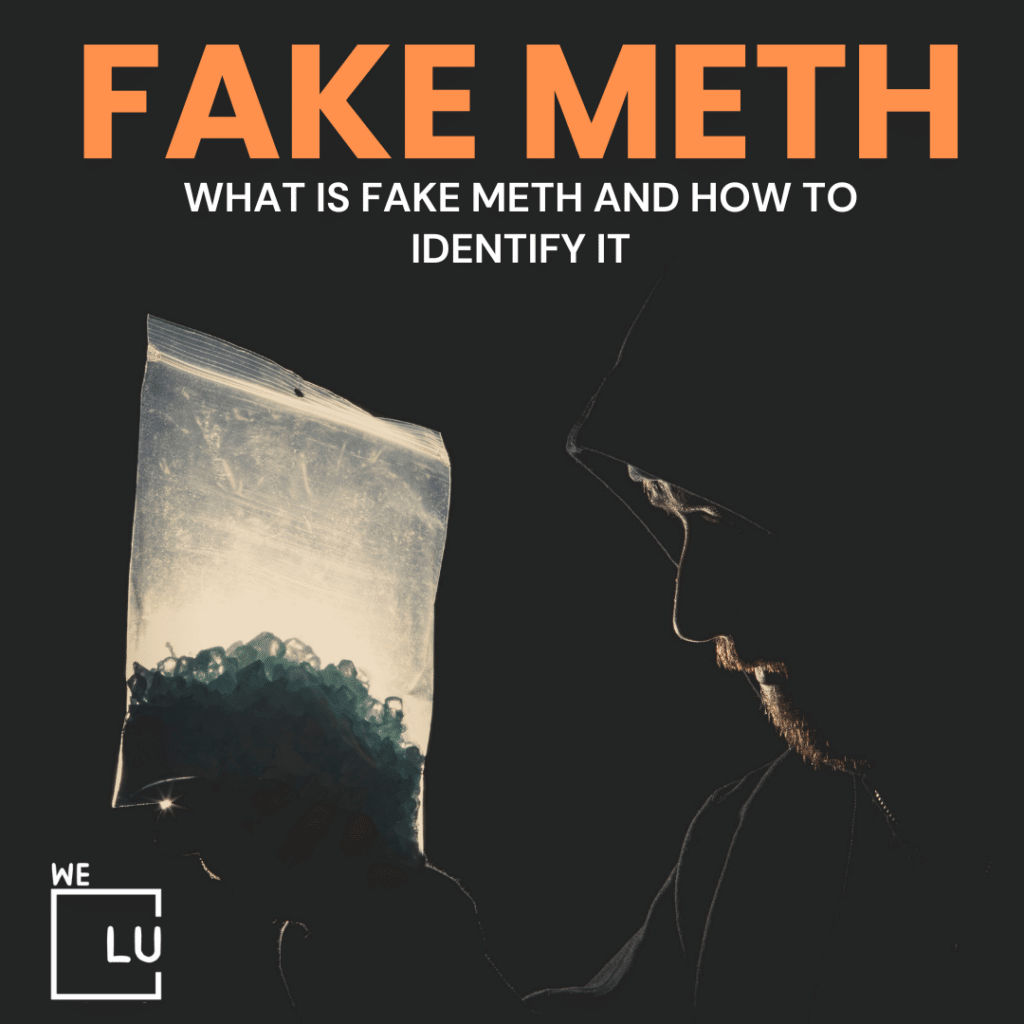
Skip To:
Learn More:
- What Does Meth Look Like? What Does Crystal Meth Look Like? Pictures of Meth.
- What Does Meth Taste Like? Identifying Meth by Taste
- Long, Short and Immediate Methamphetamine Effects
- Methamphetamine Detox, 3 Phases of Withdrawal & Treatment
- Amphetamine vs Methamphetamine, Main Differences, Stimulants Specifics, Deadly Potential & Treatment Options
- How to Cook Meth? Its Manufacturing and Cutting Processes
- What Are Meth Eyes, Meth Pupils? What Does Meth Do To Your Eyes?

Get Your Life Back
Find Hope & Recovery. Get Safe Comfortable Detox, Addiction Rehab & Dual Diagnosis High-Quality Care.
Hotline (855) 695-1160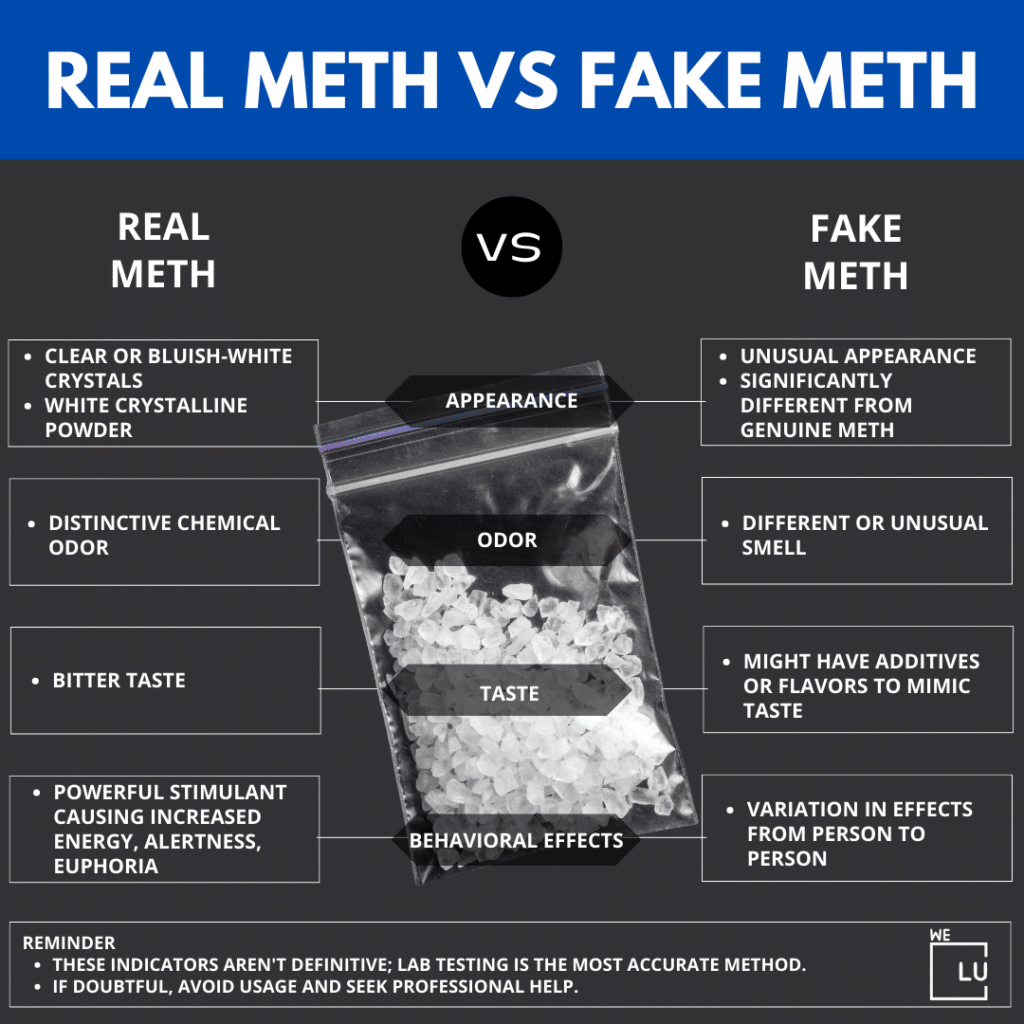
What Is Meth?
Methamphetamine, commonly known as meth, is a powerful and highly addictive central nervous system stimulant. It belongs to the amphetamine class of drugs and has effects similar to other stimulants, such as increased alertness, energy, and a sense of euphoria. Methamphetamine can take various forms, including a crystalline powder or clear crystals that resemble bluish-white rocks.
Here are some key points about methamphetamine:
- Chemical Composition: Methamphetamine’s chemical structure is similar to amphetamine, a drug used to treat attention deficit hyperactivity disorder (ADHD) and narcolepsy. However, methamphetamine has a more potent effect on the central nervous system.
- Routes of Administration: Methamphetamine can be ingested orally, snorted, smoked, or injected. Smoking or injecting the drug results in a faster and more intense onset of effects.
- Effects on the Body: Methamphetamine stimulates the release of neurotransmitters, such as dopamine, in the brain. This leads to increased energy, elevated mood, and euphoria. However, it also has numerous negative effects on the body, including increased heart rate, elevated blood pressure, decreased appetite, and increased wakefulness.
- Addictive Properties: Methamphetamine is highly addictive, and repeated use can lead to the development of tolerance, dependence, and addiction. Chronic use can have severe consequences for physical and mental health.
- Health Risks: Prolonged use of methamphetamine can result in serious health issues, including cardiovascular problems, dental issues (often referred to as “meth mouth”), skin sores, and cognitive deficits. The drug can also contribute to aggressive behavior and mental health issues.
- Illegality: Methamphetamine is a controlled substance, and its production, distribution, and use are illegal in most places without a valid prescription. The illegal production and distribution of methamphetamine often involve the use of hazardous chemicals, posing additional risks to public safety and the environment.
The illicit production and use of methamphetamine pose significant challenges to public health and law enforcement. Treatment and support programs are available for individuals struggling with methamphetamine addiction, and seeking professional help is crucial for those affected by its use.
Meth Effects
Methamphetamine, commonly known as meth, is a powerful and highly addictive central nervous system stimulant. The drug has various effects on the body and mind, both short-term and long-term. Here are some of the key effects associated with methamphetamine use:
Short-Term Effects:
- Euphoria: Methamphetamine use induces a sense of intense pleasure and euphoria, often described as a “rush.”
- Increased Energy: Users experience a significant boost in energy, increased alertness, and a feeling of being more awake.
- Reduced Appetite: Methamphetamine is an appetite suppressant, and users may go for extended periods without feeling hungry.
- Increased Heart Rate and Blood Pressure: Methamphetamine stimulates the cardiovascular system, leading to an elevated heart rate and increased blood pressure.
- Dilated Pupils: Meth use can cause pupils to dilate (enlarge).
- Enhanced Concentration: Users may experience improved focus and concentration.
- Talkativeness: Methamphetamine can lead to increased sociability and talkativeness.
Long-Term Effects:
- Addiction: Chronic use of methamphetamine can lead to the development of tolerance, dependence, and addiction.
- Cognitive Impairment: Long-term meth use is associated with cognitive deficits, including memory loss, attention problems, and difficulty with decision-making.
- Psychiatric Symptoms: Methamphetamine use can contribute to mental health issues, including anxiety, paranoia, hallucinations, and violent behavior.
- Dental Issues: “Meth mouth” is a term used to describe severe dental problems, including tooth decay and loss, associated with long-term methamphetamine use.
- Skin Issues: Users may experience skin problems, such as sores, due to picking at the skin.
- Weight Loss: Chronic methamphetamine use can lead to significant weight loss due to decreased appetite.
- Cardiovascular Problems: Long-term meth use can contribute to heart problems, including an increased risk of heart attack and stroke.
- Increased Risk of Infections: Methamphetamine use, particularly through injection, increases the risk of infectious diseases such as HIV and hepatitis.
- Social and Occupational Impairment: Methamphetamine addiction can lead to significant disruptions in personal relationships, employment, and overall functioning.
Get Help. Get Better. Get Your Life Back.
Searching for an Accredited Drug and Alcohol Rehab Centers in Near You?
Even if you have failed previously and relapsed, or are in the middle of a difficult crisis, we stand ready to support you. Our trusted behavioral health specialists will not give up on you. When you feel ready or just want someone to speak to about therapy alternatives to change your life call us. Even if we cannot assist you, we will lead you to wherever you can get support. There is no obligation. Call our hotline today.
FREE Addiction Hotline – Call 24/7How Long Does Meth Last In Your System?
The duration that methamphetamine remains detectable in your system can vary depending on several factors, including individual metabolism, frequency of use, dose, and the type of drug test being conducted. Here are general estimates for the detection window of methamphetamine in various testing methods:
- Urine Test: Methamphetamine is typically detectable in urine for 1-4 days after use. However, heavy or chronic use may result in a longer detection window.
- Blood Test: Methamphetamine can be detected in blood for about 1-3 days. Like urine testing, heavy or frequent use may extend this detection period.
- Saliva Test: Methamphetamine can be detected in saliva for a shorter period, typically up to 1-2 days after use.
- Hair Follicle Test: Methamphetamine can be detected in hair for a much longer period, often up to 90 days or more. Hair testing is less common and is usually used for detecting long-term drug use.
These are general estimates, and individual variations can occur. Factors such as metabolism, hydration, and overall health can influence how the body eliminates methamphetamine. Additionally, chronic use of methamphetamine may lead to accumulation in the body, prolonging the detection window.
If you have concerns about drug testing or the presence of methamphetamine in your system, it is advisable to consult with a healthcare professional or a toxicology expert. They can provide more personalized information based on your specific circumstances. Keep in mind that the best way to avoid positive drug test results is to refrain from using illicit substances. If you or someone you know is struggling with substance abuse, seeking help from a healthcare professional or addiction specialist is vital for proper support and treatment.
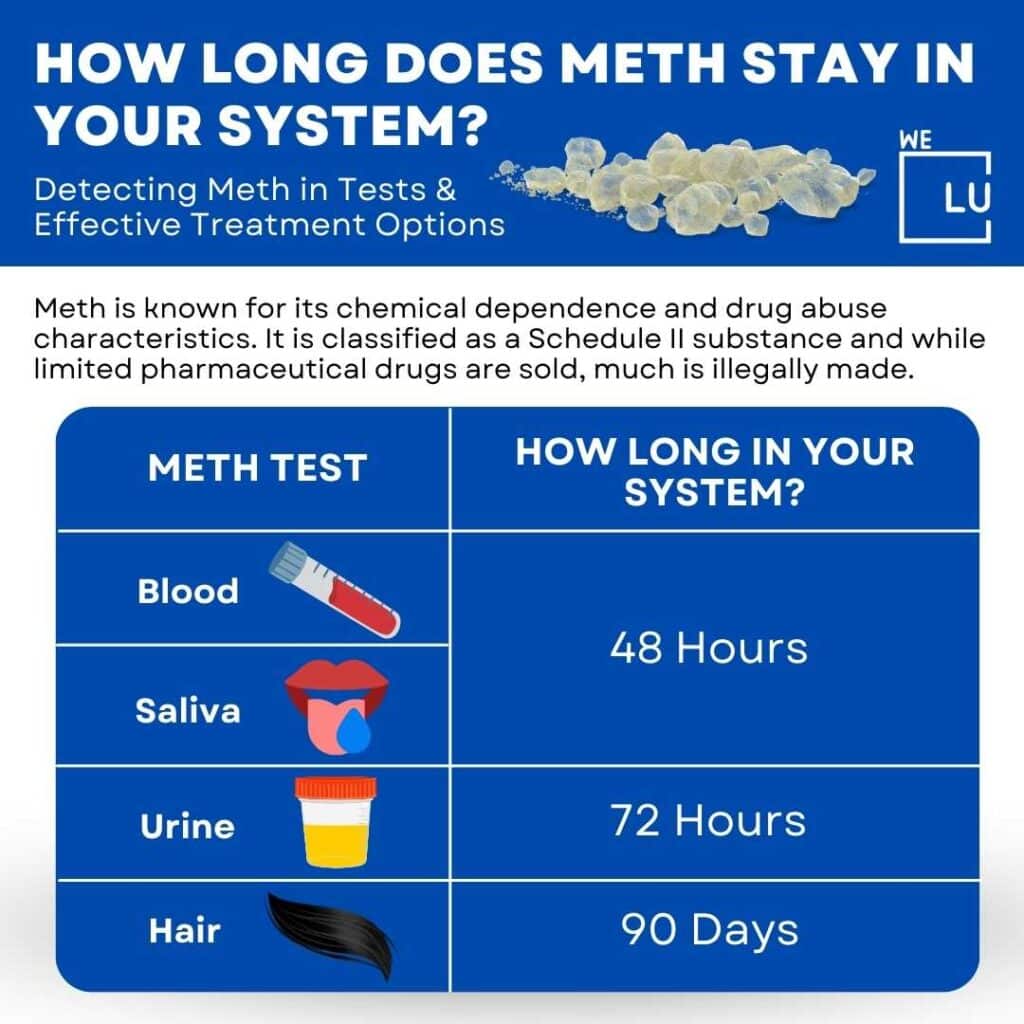
First-class Facilities & Amenities
World-class High-Quality Addiction & Mental Health Rehabilitation Treatment
Rehab Centers TourRenowned California Addiction Center. Serene Private Facilities. Inpatient rehab programs vary.
Addiction Helpline (855) 695-1160Proven recovery success experience, backed by a Team w/ History of:
15+
Years of Unified Experience
100s
5-Star Reviews Across Our Centers
10K
Recovery Success Stories Across Our Network
- Low Patient to Therapist Ratio
- Onsite Medical Detox Center
- Comprehensive Dual-Diagnosis Treatment
- Complimentary Family & Alumni Programs
- Coaching, Recovery & Personal Development Events
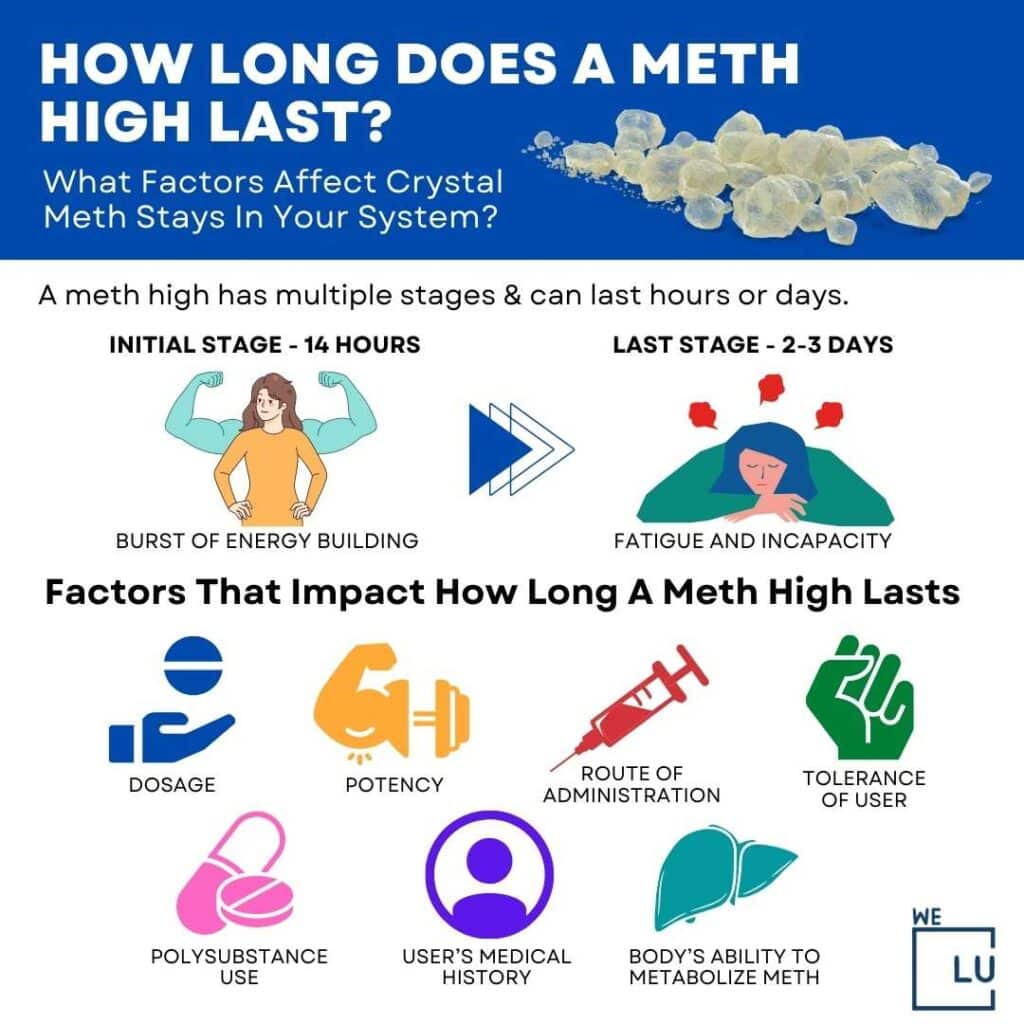
How Long Does A Meth High Last?
The duration of a methamphetamine high can vary based on factors such as the method of administration, the dose taken, individual tolerance, and the user’s overall health. Generally, the effects of methamphetamine are intense and relatively short-lived. Here are some estimations for the duration of a meth high based on different routes of administration:
- Smoking or Injecting Methamphetamine:
The effects of smoking or injecting methamphetamine are typically rapid and intense, with the peak of the high occurring within a few minutes. The duration of the high is often shorter, usually lasting around 4 to 12 hours. - Snorting Methamphetamine:
Snorting methamphetamine results in a somewhat slower onset of effects compared to smoking or injecting. The high may last slightly longer, often around 6 to 12 hours. - Oral Ingestion of Methamphetamine:
Taking methamphetamine orally results in a slower onset of effects compared to other methods. The high may last for a more extended period, typically around 8 to 16 hours.
While the acute effects of a methamphetamine high may last for the durations mentioned above, residual stimulation, insomnia, and other after-effects can persist for an extended period.
Additionally, repeated use of methamphetamine can lead to a rapid development of tolerance, meaning that individuals may require higher doses to achieve the same effects over time. Regular and chronic use of methamphetamine is associated with numerous health risks, including addiction, cardiovascular problems, dental issues, and mental health issues.
World-class, Accredited, 5-Star Reviewed, Effective Addiction & Mental Health Programs. Complete Behavioral Health Inpatient Rehab, Detox plus Co-occuring Disorders Therapy.
CALL (855) 695-1160End the Addiction Pain. End the Emotional Rollercoaster. Get Your Life Back. Start Drug, Alcohol & Dual Diagnosis Mental Health Treatment Now. Get Free No-obligation Guidance by Substance Abuse Specialists Who Understand Addiction & Mental Health Recovery & Know How to Help.
Meth Overdose
A methamphetamine overdose occurs when an individual takes a toxic amount of methamphetamine, resulting in severe and potentially life-threatening symptoms. Methamphetamine is a powerful stimulant that can have profound effects on the central nervous system, and an overdose can lead to various complications. Here are some signs and symptoms of a methamphetamine overdose:
- Increased Heart Rate: Methamphetamine stimulates the cardiovascular system, leading to a rapid and irregular heartbeat. An overdose can exacerbate these effects, potentially leading to a dangerous increase in heart rate.
- High Blood Pressure: Methamphetamine use is associated with elevated blood pressure. In an overdose, blood pressure may reach dangerously high levels, leading to cardiovascular complications.
- Hyperthermia: Methamphetamine can increase body temperature. In an overdose, hyperthermia (dangerously elevated body temperature) can occur, leading to severe health issues, including organ damage.
- Agitation and Restlessness: Overdosing on methamphetamine can intensify the stimulant effects, causing extreme agitation, restlessness, and anxiety.
- Hallucinations: Severe methamphetamine intoxication may lead to hallucinations or delusions.
- Seizures: Methamphetamine use can lower the seizure threshold, and an overdose may increase the risk of seizures.
- Loss of Consciousness: In extreme cases, a methamphetamine overdose can lead to loss of consciousness, coma, or even death.
A methamphetamine overdose is a medical emergency, and immediate intervention is crucial. If you suspect someone is experiencing a methamphetamine overdose, call emergency services immediately. While waiting for help to arrive, if the person is conscious and breathing, try to keep them calm and comfortable. Avoid giving them any substances or trying to induce vomiting unless directed to do so by emergency personnel.
It’s important to note that methamphetamine use, even in non-lethal amounts, carries significant health risks, including addiction, cardiovascular problems, dental issues, and mental health issues. Seeking professional help is essential for individuals struggling with methamphetamine use, and treatment and support services are available to assist in overcoming addiction.
Experience Transformative Recovery at the We Level Up California Treatment Center.
See our authentic success stories. Get inspired. Get the help you deserve.



Start a New Life
Begin with a free call to an addiction & behavioral health treatment advisor. Learn more about our dual-diagnosis programs. The We Level Up treatment center network delivers recovery programs that vary by each treatment facility. Call to learn more.
- Personalized Care
- Caring Accountable Staff
- World-class Amenities
- Licensed & Accredited
- Renowned w/ 100s 5-Star Reviews
We’ll Call You
“Homeless Shooting Herion Smoking Meth & Fentanyl. In & out of Drug Rehab 6 Years, Out of Jail 8. “
Search We Level Up CA Fake Meth, Drug & Alcohol Rehab / Detox & Mental Health Topics & Resources
Sources
- NIDA. 2019, May 16. Methamphetamine DrugFacts.
- NIDA. 2021, April 13. What are the long-term effects of methamphetamine misuse?. Retrieved from https://www.drugabuse.gov/publications/research-reports/methamphetamine/what-are-long-term-effects-methamphetamine-misuse on 2021, December 29
- National Institutes of Health (NIH) – Methamphetamine: https://medlineplus.gov/methamphetamine.html.
- National Criminal Justice Reference Service (NCJRS) – Methamphetamine: https://www.ncjrs.gov/ondcppubs/publications/policy/04meth.html.
- United States Department of Health and Human Services (HHS) – Methamphetamine: https://www.hhs.gov/ash/oah/adolescent-development/substance-use/drugs/stimulants/methamphetamine/index.html.
